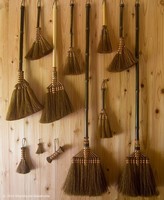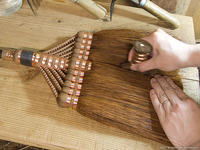

Total:131items
- Pottery & Porcelain (18)
- Lacquerware (4)
- Glasswork (2)
- Wood & Bamboo Work (19)
- Hakone Yosegi Zaiku: Hakone Marquetry
- Boshu Uchiwa: Boshu Fans
- Nikko-bori: Nikko carving
- Sasebo Koma (Sasebo Spinning Top)
- Shimoda Yanimatsu Zaiku (Shimoda Joinery of Oily Pine)
- Echizen Takeningyo (Bamboo Dolls)
- Osaka Senshu Kiri-dansu: Paulownia chest of drawers or wardrobes of Senshu, Osaka
- Kitayama Maruta: Japanese cedar logs
- Yodoegasa: Yodoe umbrella
- Atami Kusu Zaiku: Atami Camphor wood crafts
- Kawatsura Kokeshi Doll
- Itaya Zaiku: Itaya Bark Craft
- Yokohama Classic Furniture
- Hinaga Uchiwa: Hinaga Fan
- Torafu Takezaiku: Tiger Bamboo Work
- Tsuruzaiku: Woven Vine Craft
- Okawa Kumiko: Okawa Kumiko Wood Joinery
- Shuro Houki: Hemp-palm Broom
- Furyumen: Wood Carving Mask
- Leather Work (1)
- Papermaking (13)
- Textile (20)
- Dyeing products (5)
- Masonry (1)
- Metal Work (11)
- Stationery (4)
- Livingware (3)
- Accessory (4)
- Toys & Entertainment (14)
- Interior (2)
- Other crafts (10)

 |
Main Production Site:Wakayama |
 《Characteristics》
《Characteristics》Shuro Houki, a hemp-palm broom, is a Japanese broom whose head is made from the bark of a hemp-palm tree. This traditional Japanese broom is said to have a long history dating back several hundred years. Shuro Houki is more long-lasting than other types of Japanese brooms, and even among Shuro Houki, “Hon-onike Houki” especially provides the longest useful life and has gained a reputation for its strength and durability. In the past, craftsmen in Kyoto Prefecture and various areas in western Japan made Shuro Houki, which was unique to each region or craftsmen.
The raw fiber of the hemp-palm bark is much superior to many other natural fibers. Its fine, elastic and flexible fiber provides durability and resistance to decay. Therefore, it was frequently used to make rope and nets for ship fittings, packaging and transportation, and architecture. Shuro Houki and Shuro Tawashi, a scrubbing brush, also take advantage of durability, even though they are made of all natural materials.
There are three types of Shuro Houki: Hon-onike Houki, Onike Houki and Kawa*Houki. Both Hon-onike Houki and Onike Houki can be repaired and lasts a long time. On the other hand, Kawa Houki is basically expendable and is not repaired. All of these types of Shuro Houki are made from hemp-palm bark, but the tension, elasticity and durability of the head of each type are not the same. Fibers arranged for each type are different in their thickness and quality, being selected from different parts of the bark. Moreover, each type of Shuro Houki is made by a different process.
* Kawa means “bark”
◎Hon-onike Houki: Repairable and Long-lasting Broom
Hon-onike Houki is well-known as a top-quality Shuro Houki. It provides the greatest durability among other types of Japanese brooms. Hon-onike Houki is mainly made from beautiful, thick and particularly durable fibers of the hemp-palm tree. These special fibers are called “Onige” (also called “Hon-onike” or “Tachike”), which are individually selected by hand from the bark of a hemp-palm tree. Moreover, a few leftover fibers of the bark, called “Taishi”, are also used. It is said that Hon-onike Houki will last for more than 20 years if regular repairs are made. Its durability, therefore, is praised, “Only three Hon-onike Houki brooms are needed in one’s lifetime.”
◎Onike Houki (originally called “Taishi Houki”): Repairable and Long-lasting Broom--second only to the Hon-onike Houki in quality
Onike Houki is made with thick, stiff and high-quality fibers of the hemp-palm tree, called “Taishi”, which are randomly selected fibers. It is also repairable and said to last between 15 and 20 years.
◎Kawa Houki: Expendable Broom
Kawa Houki has been commonly used at home as a cleaning tool for a long time, to sweep tatami mats or wood floors. It is made from the hemp-palm bark fresh off the tree in the following way: sheets of bark, peeled off the tree, are rolled and bound; the bundles are tied together and the end of each bundle is split to become a broom head. Made in such a simple way, Kawa Houki is said to be a prototype of all types of present-day Shuro Houki. Its lifetime is expected to be 2 to 5 years when made from average quality bark. It will last, however, for 10 to 15 years if high-quality bark is used.
Shuro Houki is characterized by the thickness of the broom head and the comfort of use. Its flexible, thin fibers provide for gentle sweeping and capturing fine dust, without stirring up dirt. Since no static electricity is generated, all of the captured dirt and hair easily come free of the fibers. In addition, the fibers will not scratch or damage tatami mats or wood floors. It is said, therefore, the continuous cleaning of floors with both Shuro Houki and cleaning cloth will polish floor materials naturally.
After being used indoors for years and becoming worn down, Shuro Houki can be reused outdoors or dirt floors and in gardens. Shuro Houki is highly valued and used until it is totally worn out.
[Local Traditional Craft designated by the Governor of Wakayama Prefecture]
Courtesy of SHUROHOUKI SEISAKUSHA
Translation by Tae Yamaguchi, reviewed by Marina Izumi

| Materials | The bark and fibers of a hemp-palm tree, bamboo, straw, string, copper wire, tacks and nails |
|---|---|
| Crafting Processes | [1] Fiber Preparation and Sorting
First, bundles of hemp-palm tree fibers are soaked in water. Then, each small bundle of fibers is straightened and waste, such as short fibers and palm tree powder,* is removed using “fiber-processing machine”-- a special motorized machine that has a rolling drum studded with several rows of metal combs. After that, the fibers are sorted based on quality and length, cut to a prescribed length and air-dried. * palm tree powder: natural, harmless powder which fills the spaces between each fiber of hemp-palm bark [2] Broom Handle Preparation Black bamboo is cut to a prescribed length for the broom handle. Then, a hole is drilled through one end of it. The nodes of the bamboo should be scraped off. [3] Kougai Stick (Bamboo Stick) Preparation A bamboo stick called Kougai is made from Moso bamboo (Phyllostachys edulis)--which is cut down in winter and air-dried--in the following way: the bamboo is cut to a prescribed length and split with a hatchet; a piece of the bamboo is shaped into a stick with a knife, and then the stick is burnt slightly as a finish. [4] Tama (Bundles) Preparation The hemp-palm fibers (prepared in step [1]) are layered and rolled up, surrounding both the leftover hemp-palm fibers and a few glutinous rice straws*--these are the core of the bundle. Then, the bundle is wrapped tightly with twine or copper wire. This bundle is called Tama, and the number of Tama bundles used for a broom determines the width of the broom; for example, a long-handled Shuro Houki has 3 width: “11-Tama bundle”, “9-Tama bundle” and “7-Tama bundle”. One bundle of each type is attached to a long broom handle. *glutinous rice straw: a by-product of sticky rice plants. It is said to be stickier and stronger than regular rice straw. [5] Attaching Tama Bundles to the Broom Handle The prepared individual Tama bundles are attached to a broomstick to form a Shuro Houki. The broomstick with a Tama bundle (prepared in step [4]) has a hole drilled on the bundle side, so, first, the Kougai stick (prepared in step [3]) is threaded through the hole. (At this point, the bundle with the broomstick is placed at the center of the Kougai stick.) Next, the rest of the Tama bundles are threaded through the Kougai stick and properly affixed one by one, making sure that the broom head is symmetrical. Lastly, the ends of the Kougai stick, which sticks out from both ends of the Tama bundles, are cut off, then tacks or nails are used to reinforce the broom. [6] Trimming The Broom Head After being soaked in water, the finished broom head is again sprayed thoroughly with water. Then, it is combed out with the fiber-processing machine or an iron hand rake, and is polished with a brush made of “Onige” fibers. Lastly, the bottom of the broom is trimmed evenly and the broom is air-dried. [7]Finishing Waste, such as short fibers or palm tree powder, is removed from the dried broom head, and the fluff is burned off if necessary. Afterwards, step [6] is repeated, and when a string is threaded through the top of the broomstick, the whole process is complete. |
| History | Although it is not certain when Shuro Houki first began to be produced, it is said to have been used since before the Edo period. That is, Shuro Houki has a much longer history than “Broomcorn broom”, which appeared in the late Edo period (in the 1860s). Though household tools, like brooms, are generally not mentioned in historical records, brooms can be seen in paintings of the Edo period. Shuro Houki spread mainly in Kyoto Prefecture, and it is supposed that Shuro Houki began to be made in the Nokamidani area (present-day the Kimino-cho area, Wakayama Prefecture, and Arida River basin) in the late Edo period.
In the postwar Showa period, the Todoroki area (Wakayama Prefecture, and where the Town Hall is located), palm fiber products such as rope, scrubbing brushes called Tawashi, mats and brooms were being produced, mainly because Nokamidani was the largest producer of hemp-palm trees in Japan. It is said that there were more than 20 individual manufacturers exclusively producing and selling Shuro Houki. Shuro Houki was in its “Golden Age” in those days. Shuro Houki was usually produced in a cottage industry. Each family produced Shuro Houki, ranging from inexpensive, mass-produced ones to high-quality ones, and they were put on the market mainly in western Japan by local merchants and traveling salesmen. In very limited areas, many craftsmen competed with each other over their skills. Some took advantage of the division of labor to mass-produce inexpensive Shuro Houki, and others exclusively produced high-quality, custom-made ones. Through this friendly rivalry and with great effort, each of them produced more comfortable, more durable and more beautiful brooms. As a result, Shuro Houki developed into its present design and form. Regrettably, as the demand for palm fiber products decreased, the cultivation of hemp-palm trees in Wakayama Prefecture declined around 1965. Most hemp-palm trees were replaced with Japanese cedar or Japanese cypress trees, so that good quality domestic hemp-palm trees are not available anymore. Instead, using imported hemp-palm trees--which are carefully selected--, skilled craftsmen produce Shuro Houki today. Nowadays, Shuro Houki is more highly valued for its features--its functionality, durability and aesthetic appearance. |
| Related URL | http://shurohouki.jp |
◆Exhibition / Showcase
For more information:
Kimino-cho Town Hall, Industries Division
Business hours: 8:30 AM to 5:15 PM
Address:
287 Todoroki, Kimino-cho, Kaiso-gun, Wakayama
640-1131 JAPAN
Tel: +81-73-489-2430 (Japanese Only)
◆Event Information
Assistance needed? For inquiries in English:
JTCO Contact Form
Your inquiries will be forwarded by JTCO in Japanese to the organization you wish to contact.
*Please write the name of craft you wish to ask about.



